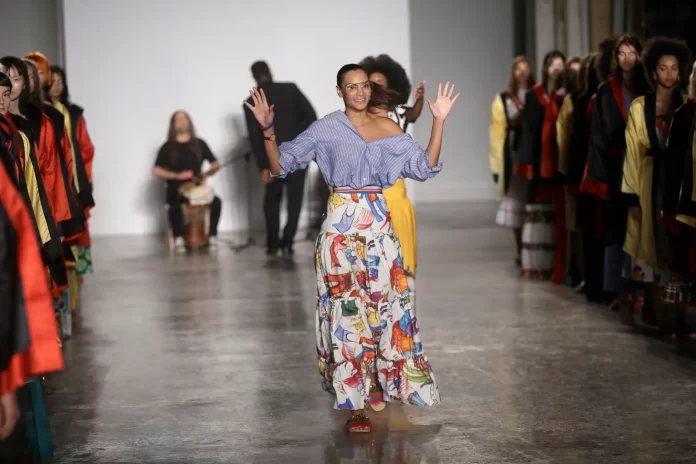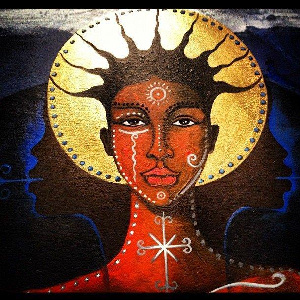Stella Jean, one of the few Black designers in Italian fashion, protests her industry’s lack of diversity and inclusion.
The designer Stella Jean has often cut a solitary figure.
Since her debut at Milan Fashion Week in 2013, and with support from Giorgio Armani, the Haitian-Italian designer remains the only Black member of the National Chamber of Italian Fashion. She has often used her platform to address the need for better representation and financial support for design talent of color in the Italian fashion industry — a sector long criticized over instances of racism and cultural appropriation. In recent years, she has undertaken increasingly radical steps to encourage racial equity, co-founding a collective called WAMI, or We Are Made in Italy, after the Black Lives Matter movement in 2020.
Ms. Jean announced she would go on a hunger strike after a dramatic showdown at a news conference on Feb. 8 with Carlo Capasa, the chairman of the powerful national chamber, known officially as the Camera Nazionale della Moda Italiana, which organizes the Milan fashion shows that take place each spring and fall. She accused the chamber of “abandoning” WAMI and its promotion of young designers of color working in Italy, saying that she believed they had cut their support after a speech she made last September highlighting the challenges of being Black and Italian in the industry.
Now, she is taking this extreme step — saying she fears ongoing professional “recriminations” against her and the designers in her collective — to safeguard the less visible members of WAMI, which she co-founded with the African American designer Edward Buchanan, who is based in Milan, and Michelle Ngonmo, who leads the Afro Fashion Association. The Camera had provided financial and institutional support for WAMI members to produce and present three collections as part of Milan Fashion Week. But in an October letter sent to Ms. Ngonmo, Mr. Capasa said that WAMI was “no longer in line with the current strategy,” adding that the Camera would continue to assess support for collections or projects by the collective on an ad hoc basis. Facing a considerable reduction in funding for the project, Ms. Jean said WAMI’s operations would be suspended, citing the “health and well being” of its members.

“After we confirmed the Camera’s abandonment of WAMI without further specifications and assurances,” Ms. Jean said over a video call, “some collective members confided in me that they feared the worst for themselves and their livelihoods as they suddenly found themselves in an extremely critical and time-sensitive situation.”
She added, “I found myself holding the responsibility of the lives of these people who had relied on and believed in WAMI and who at that moment had their lives hanging in the balance. That’s why I offered to swap what little I could. I understood that if I stopped demanding equal opportunity, Mr. Capasa would, in turn, have a guarantee that nothing would ever happen to any of these designers or people working in fashion.”
In an email sent to The New York Times, Mr. Capasa said the Camera Della Moda had not withdrawn its support for WAMI. He said that he had offered the collective a free venue for Milan Fashion Week, which begins on Feb. 21, and that slots on the calendar remained available and at no charge to WAMI designers and Ms. Jean, who announced that she would no longer participate in the show.
“No step backward was taken on our part on the support we offered. Economic support for the production of collections and events for brands is not part of the core of Cameras’s activities. Any additional economic support may be one-off for new brands, especially at the beginning of their journey,” Mr. Capasa wrote. Although there was never a signed partnership, he added, “we are very proud to have always supported WAMI and the Afro Fashion Association projects, adopting different ways depending on the possibilities available at different times.”
Mr. Capasa said that two previous WAMI designers were presenting collections as part of the official calendar in Milan this season, and that there would be a new event, the Black Carpet Awards, to be held on Feb. 24, that would showcase work by Italian-based designers of color.
Ms. Jean previously stepped away from the fashion calendar in 2020, saying that she would not return until there were more Black designers on the schedule. Last season, two non-Italian designers of color — Maximilian Davis and Rhuigi Villaseñor — made debuts at Salvatore Ferragamo and Bally, partly spurring Ms. Jean’s comeback show last September. On Friday, Mr. Capasa added that he regretted that neither Ms. Jean nor several WAMI members would present during the fashion week and he hoped that would change.
While Ms. Jean praised the appointment of Mr. Davis, who is British-Trinidiadian, and Mr. Villaseñor, who is Filipino American, in European fashion houses, calling it “important and symbolic,” she also said that designers of color who might fall under the category of “made in Italy” were “completely ignored.” Talent cannot only be exported, she argued. It must also be homegrown — including by investing in and supporting young talent accessing college placements, internships, jobs or even showing collections on the mainstream calendar.
“Black made in Italy can speak to and tell so many things about the national condition and what happens in this country,” Ms. Jean said.

“I’m mindful of the fact that I arrived with a blue U.S. passport here and a Parsons degree,” said Mr. Buchanan, a co-founder of WAMI who has lived in Milan for two decades. “But if I had a passport from Nigeria or Somalia, it would have likely been a different story.”
He called Ms. Jean’s decision to go on a hunger strike “a personal one,” though he agreed with her statements about the challenges of being Black and working in fashion in Italy. “I can’t say enough about these struggles and difficulties,” he said. “I have had many of them, too, and ultimately I have been within the interiors of the fashion establishment in Italy for 25 years.”
The global fashion industry has been under sustained pressure in recent years to improve representation and racial equity both in front of and behind the camera. But several racist gaffes by Italian fashion houses, including Gucci’s 2019 “blackface” sweater with a mouth cut out and trimmed in red, and Prada’s 2018 keychain of a monkey with inflated lips, has placed Italian fashion under particular scrutiny.
Italy is whiter than most European countries — and does not collect racial data in its population census, nor does it have birthright citizenship, which means that children of immigrants who are born in the country do not automatically become Italian citizens.
In a New York Times investigation published in 2021 that attempted to track representation progress, many Italian brands said regulation prohibited companies from processing data on race, ethnicity, political opinions, religious beliefs, trade union membership or sexual orientation without explicit consent. This meant they were unable to participate in charting whether there were more people of color in their design studios, sales rooms, on their runways and in their campaigns.
For Ms. Jean, the future of minority talent in the Italian fashion establishment remains far from certain. She said her hunger strike felt like a last stand after feeling as though she and her younger peers had been professionally blacklisted for their activism.
“I’m a small independent designer, and I’m the only Black-owned brand in the history of fashion of the Chamber — this does not make me stronger than others,” she said. “I’m always aware of being a flea near these giants and of my perceived inability to put convincing arguments on the table. When I learned that my companions were in such a disparate situation, I had nothing else left to barter with.”




























![Phyllisia Ross – KONSA [Official Music Video]](https://haitiville.com/wp-content/uploads/2014/08/phyliisia.jpg)










